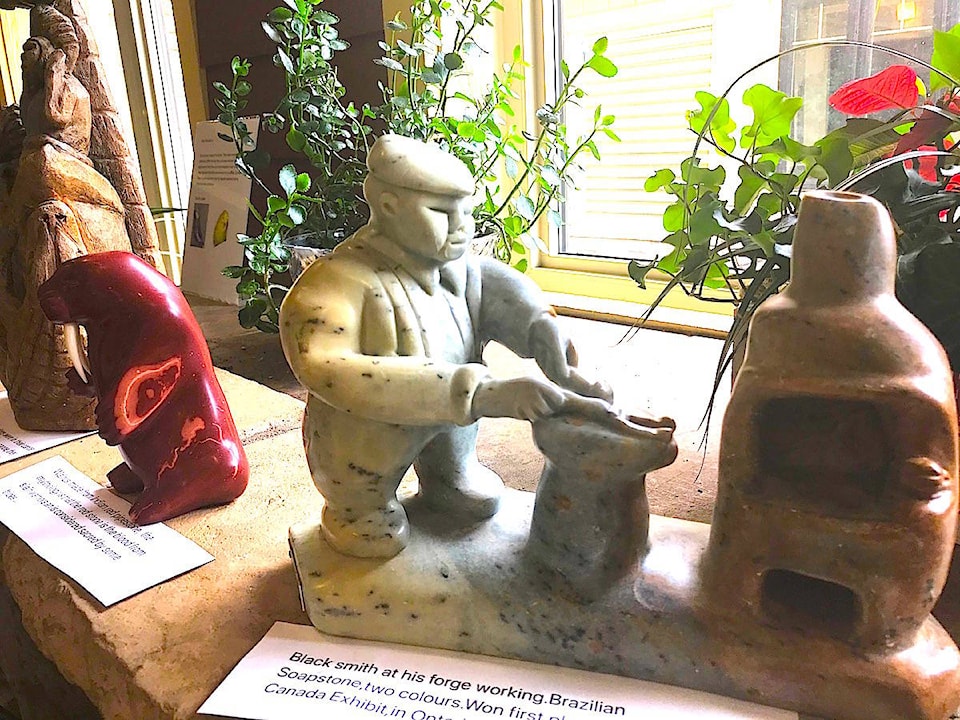Art has always helped Edward Plover navigate through life’s difficulties — from growing deafness to pandemic isolation.
When Plover’s relatives couldn’t visit his retirement Inglewood home because of COVID-19 protocols, the 86-year-old spent much of 2020 and early 2021 creating whimsical sculptures.
His materials changed from stone to plastic wrap because his doctor doesn’t want him to potentially injure his eyes as he awaits for cataract surgery.
But Plover’s creativity is fuelled by the same inspiration that sparked his intricate, award-winning stone carvings that were exhibited in galleries across North America.
“You are using your imagination,” explained the artist.
Plover focuses on an idea and his thoughts are lifted to a higher plane. He said, “You are always seeing things as if they are almost finished. They are already completed in your mind, so you are always thinking two or three steps ahead, like a chess game…”
The Quebec native, who moved to Red Deer to be closer to his son and grandchildren four years ago, didn’t set out to be an artist. He never even thought he was particularly artistic.
In the mid 1950s he was a bulldozer operator on Baffin Island in Nunavut where he was helping create the DEW Line (the Distant Early Warning line consisted of a series of radar stations built across the Arctic, from Alaska to Greenland, to detect enemy bombers that might come over the North Pole during the Cold War).
Plover watched a couple of Inuit co-workers carve soapstone sculptures in their free time. “I thought I’d like to learn to carve stone someday…”
He later worked as a police officer, but retired from the force at age 43 when he started to lose his hearing.
Doctors told him he had a progressive condition that would ultimately leave him deaf. Twelve years later, Plover set aside his useless hearing aids and began learning sign language and lip reading.
During this time he felt socially isolated, and art became a vital outlet. He recalled it allowed him to focus on the mythological creatures he was carving out of stone and wood instead of his everyday troubles.
His sculptural subject matter is often borrowed from Inuit and First Nations legends — an owl/buffalo sculpture, for instance, relates how bison got their humps. According to legend, the burrowing owl blamed the buffalo for stepping on its in-ground nest, so dropped a large rock on its back.
Plover’s carving skills were honed when he took lessons from Mohawk artisans at the Kahnawake Reserve. He also took classes at the Saidye Bronfman Centre of the Arts in Montreal, and several art studios in Florida, where he spent his winters.
The artist, whose hearing difficulties were eased after he received cochlear implants at age 55, figures he’s sold about 500 sculptures, of birds, alligators, humans and many other creatures over the years. His works have been exhibited from Chateauguay, Que., to Toronto and Fort Myers, Florida.
Plover’s wife died seven years ago, after 53 years of marriage. While he has two daughters living in Toronto, he opted to trade the bustle for a more tranquil existence in Red Deer, where his son lives.
His works — from wood to soapstone to plastic wrap — are now displayed for the enjoyment of residents of the Revera Inglewood retirement home. Red Deerians have been friendly and given him good feedback, said Plover.
Of all the materials he’s worked with, his favourite medium is alabaster: “You have the ability to make fine features in it and you can get some beautiful colours…”
lmichelin@reddeeradvocate.com
Like us on Facebook and follow us on Twitter
